Saccharide Alterations in Spruce Wood Due to Thermal and Accelerated Aging Processes
Abstract
1. Introduction
2. Materials and Methods
2.1. Material
2.2. Accelerated Aging
2.3. Chemical Analyses
2.4. XRD Analysis
2.5. Size Exclusion Chromatography
2.6. ATR-FTIR Analysis
3. Results and Discussion
4. Conclusions
Author Contributions
Funding
Institutional Review Board Statement
Data Availability Statement
Conflicts of Interest
References
- Búryová, D.; Sedlák, P. Life Cycle Assessment of Coated and Thermally Modified Wood Façades. Coatings 2021, 11, 1487. [Google Scholar] [CrossRef]
- Sandberg, D.; Kutnar, A.; Mantanis, G. Wood Modification Technologies—A Review. iForest 2017, 10, 895. [Google Scholar] [CrossRef]
- Hill, C.; Altgen, M.; Rautkari, L. Thermal Modification of Wood—A Review: Chemical Changes and Hygroscopicity. J. Mater. Sci. 2021, 56, 6581–6614. [Google Scholar] [CrossRef]
- de Oliveira Araújo, S.; Rocha Vital, B.; Oliveira, B.; Oliveira Carneiro, A.d.C.; Lourenço, A.; Pereira, H. Physical and Mechanical Properties of Heat Treated Wood from Aspidosperma populifolium, Dipteryx odorata and Mimosa scabrella. Maderas Cienc. Tecnol. 2016, 18, 143–156. [Google Scholar] [CrossRef]
- Javed, M.A.; Kekkonen, P.M.; Ahola, S.; Telkki, V.-V. Magnetic Resonance Imaging Study of Water Absorption in Thermally Modified Pine Wood. Holzforschung 2014, 69, 899–907. [Google Scholar] [CrossRef]
- Thakur, R.; Dutt, B.; Kumar, R.; Sharma, Y.P.; Pingale, A. Optimizing Physical and Mechanical Attributes of Acrocarpus fraxinifolius Wood via Heat Treatment. Int. J. Adv. Biochem. Res. 2024, 8, 260–267. [Google Scholar] [CrossRef]
- Calonego, F.W.; Severo, E.T.D.; Furtado, E.L. Decay Resistance of Thermally-Modified Eucalyptus grandis Wood at 140 °C, 160 °C, 180 °C, 200 °C and 220 °C. Bioresour. Technol. 2010, 101, 9391–9394. [Google Scholar] [CrossRef]
- Lekounougou, S.; Kocaefe, D. Comparative Study on the Durability of Heat-Treated White Birch (Betula papyrifera) Subjected to the Attack of Brown and White Rot Fungi. Wood Mater. Sci. Eng. 2012, 7, 101–106. [Google Scholar] [CrossRef]
- Paes, J.; Brocco, V.; Loiola, P.; Segundinho, P.; Silva, M.; Juizo, C. Effect of Thermal Modification on Decay Resistance of Corymbia citriodora and Pinus taeda Wood. J. Trop. For. Sci. 2021, 33, 185–190. [Google Scholar] [CrossRef]
- Borrega, M.; Kärenlampi, P.P. Mechanical Behavior of Heat-Treated Spruce (Picea abies) Wood at Constantmoisture Content and Ambient Humidity. Holz Roh. Werkst. 2008, 66, 63–69. [Google Scholar] [CrossRef]
- Herrera-Builes, J.F.; Sepúlveda-Villarroel, V.; Osorio, J.A.; Salvo-Sepúlveda, L.; Ananías, R.A. Effect of Thermal Modification Treatment on Some Physical and Mechanical Properties of Pinus oocarpa Wood. Forests 2021, 12, 249. [Google Scholar] [CrossRef]
- Rowell, R.M.; Ibach, R.E.; McSweeny, J.; Nilsson, T. Understanding Decay Resistance, Dimensional Stability and Strength Changes in Heat-Treated and Acetylated Wood. Wood Mater. Sci. Eng. 2009, 4, 14–22. [Google Scholar] [CrossRef]
- Yang, T.-H.; Lee, C.-H.; Lee, C.-J.; Cheng, Y.-W. Effects of Different Thermal Modification Media on Physical and Mechanical Properties of Moso Bamboo. Constr. Build. Mater. 2016, 119, 251–259. [Google Scholar] [CrossRef]
- Pelaez-Samaniego, M.R.; Yadama, V.; Lowell, E.; Espinoza-Herrera, R. A Review of Wood Thermal Pretreatments to Improve Wood Composite Properties. Wood Sci. Technol. 2013, 47, 1285–1319. [Google Scholar] [CrossRef]
- Torniainen, P.; Popescu, C.-M.; Jones, D.; Scharf, A.; Sandberg, D. Correlation of Studies between Colour, Structure and Mechanical Properties of Commercially Produced ThermoWood® Treated Norway Spruce and Scots Pine. Forests 2021, 12, 1165. [Google Scholar] [CrossRef]
- Fengel, D.; Wegener, G. Wood: Chemistry, Ultrastructure, Reactions; Walter de Gruyter: Berlin, Germany, 2011; pp. 66–131. ISBN 978-3-11-083965-4. [Google Scholar]
- Sjöström, E. Wood Polysaccharides. In Wood Chemistry, 2nd ed.; Sjöström, E., Ed.; Academic Press: San Diego, CA, USA, 1993; pp. 51–70. ISBN 978-0-08-092589-9. [Google Scholar]
- Zhang, N.; Li, S.; Xiong, L.; Hong, Y.; Chen, Y. Cellulose-Hemicellulose Interaction in Wood Secondary Cell-Wall. Model. Simul. Mater. Sci. Eng. 2015, 23, 085010. [Google Scholar] [CrossRef]
- Zachar, M.; Čabalová, I.; Kačíková, D.; Jurczyková, T. Effect of Natural Aging on Oak Wood Fire Resistance. Polymers 2021, 13, 2059. [Google Scholar] [CrossRef]
- Ou, J.; Zhao, G.; Wang, F.; Li, W.; Lei, S.; Fang, X.; Siddiqui, A.R.; Xia, Y.; Amirfazli, A. Durable Superhydrophobic Wood via One-Step Immersion in Composite Silane Solution. ACS Omega 2021, 6, 7266–7274. [Google Scholar] [CrossRef]
- Yang, L.; Liu, H.-H. Effect of a Combination of Moderate-Temperature Heat Treatment and Subsequent Wax Impregnation on Wood Hygroscopicity, Dimensional Stability, and Mechanical Properties. Forests 2020, 11, 920. [Google Scholar] [CrossRef]
- Wang, Z.; Yang, X.; Sun, B.; Chai, Y.; Liu, J.; Cao, J. Effect of Vacuum Heat Treatment on the Chemical Composition of Larch Wood. BioResources 2016, 11, 5743–5750. [Google Scholar] [CrossRef]
- Kačíková, D.; Kačík, F.; Čabalová, I.; Ďurkovič, J. Effects of Thermal Treatment on Chemical, Mechanical and Colour Traits in Norway Spruce Wood. Bioresour. Technol. 2013, 144, 669–674. [Google Scholar] [CrossRef] [PubMed]
- Wikberg, H.; Liisa Maunu, S. Characterisation of Thermally Modified Hard- and Softwoods by 13C CPMAS NMR. Carbohydr. Polym. 2004, 58, 461–466. [Google Scholar] [CrossRef]
- Sikora, A.; Hájková, K.; Jurczyková, T. Degradation of Chemical Components of Thermally Modified Robinia pseudoacacia L. Wood and Its Effect on the Change in Mechanical Properties. Int. J. Mol. Sci. 2022, 23, 15652. [Google Scholar] [CrossRef] [PubMed]
- Fengel, D.; Fengel, D. Über die Veränderungen des Holzes und seiner Komponenten im Temperaturbereich bis 200°C— Vierte Mitteilung: Das Verhalten der Cellulose im Fichtenholz bei thermischer Behandlung. (On the Changes in the Chemical Composition of Wood within the Temperature Range up to 200 °C—Part IV: The Behaviour of Cellulose in Sprucewood under Thermal Treatment). Holz Roh. Werkst. 1967, 25, 102–111. [Google Scholar] [CrossRef]
- Sweet, M.S.; Winandy, J.E. Influence of Degree of Polymerization of Cellulose and Hemicellulose on Strength Loss in Fire-Retardant-Treated Southern Pine. Holzforschung 1999, 53, 311–317. [Google Scholar] [CrossRef]
- Yildiz, S.; Gezer, E.D.; Yildiz, U.C. Mechanical and Chemical Behavior of Spruce Wood Modified by Heat. Build. Environ. 2006, 41, 1762–1766. [Google Scholar] [CrossRef]
- Antons, A.; Cīrule, D.; Andersone, I.; Verovkins, A.; Kuka, E. Influence of Different Modifications on Bending Strength of Wood. Key Eng. Mater. 2019, 800, 240–245. [Google Scholar] [CrossRef]
- Kim, P.; Taylor, A.; Lloyd, J.; Kim, J.-W.; Abdoulmoumine, N.; Labbé, N. Two-Step Thermochemical Process for Adding Value to Used Railroad Wood Ties and Reducing Environmental Impacts. ACS Sustain. Chem. Eng. 2017, 5, 9485–9493. [Google Scholar] [CrossRef]
- Zhao, X.; Xiong, L.; Zhang, M.; Bai, F. Towards Efficient Bioethanol Production from Agricultural and Forestry Residues: Exploration of Unique Natural Microorganisms in Combination with Advanced Strain Engineering. Bioresour. Technol. 2016, 215, 84–91. [Google Scholar] [CrossRef]
- Luo, S.; Cao, J.; Peng, Y. Properties of Glycerin-Thermally Modified Wood Flour/Polypropylene Composites. Polym. Compos. 2013, 35, 201–207. [Google Scholar] [CrossRef]
- Miao, J.; Yu, Y.; Jiang, Z.; Tang, L.; Zhang, L. Partial Delignification of Wood and Membrane Preparation Using a Quaternary Ammonium Ionic Liquid. Sci. Rep. 2017, 7, 42472. [Google Scholar] [CrossRef] [PubMed]
- Dimos, K.; Paschos, T.; Louloudi, A.; Kalogiannis, K.G.; Lappas, A.A.; Papayannakos, N.; Kekos, D.; Mamma, D. Effect of Various Pretreatment Methods on Bioethanol Production from Cotton Stalks. Fermentation 2019, 5, 5. [Google Scholar] [CrossRef]
- Vilcekova, S.; Monokova, A.; Meciarova, L.; Selecka, I. Methodological Evaluation of Family House with Different Thermo-Physical Parameters of Building Materials. Proceedings 2018, 2, 1277. [Google Scholar] [CrossRef]
- Pourhashem, G.; Adler, P.R.; McAloon, A.J.; Spatari, S. Cost and Greenhouse Gas Emission Tradeoffs of Alternative Uses of Lignin for Second Generation Ethanol. Environ. Res. Lett. 2013, 8, 025021. [Google Scholar] [CrossRef]
- Vasco-Correa, J.; Shah, A. Techno-Economic Bottlenecks of the Fungal Pretreatment of Lignocellulosic Biomass. Fermentation 2019, 5, 30. [Google Scholar] [CrossRef]
- Chundawat, S.P.S.; Donohoe, B.S.; Sousa, L.d.C.; Elder, T.; Agarwal, U.P.; Lu, F.; Ralph, J.; Himmel, M.E.; Balan, V.; Dale, B.E. Multi-Scale Visualization and Characterization of Lignocellulosic Plant Cell Wall Deconstruction during Thermochemical Pretreatment. Energy Environ. Sci. 2011, 4, 973–984. [Google Scholar] [CrossRef]
- Yip, K.; Xu, M.; Li, C.-Z.; Jiang, S.P.; Wu, H. Biochar as a Fuel: 3. Mechanistic Understanding on Biochar Thermal Annealing at Mild Temperatures and Its Effect on Biochar Reactivity. Energy Fuels 2010, 25, 406–414. [Google Scholar] [CrossRef]
- Janiszewska, D.; Olchowski, R.; Nowicka, A.; Zborowska, M.; Marszałkiewicz, K.; Shams, M.; Giannakoudakis, D.A.; Anastopoulos, I.; Barczak, M. Activated Biochars Derived from Wood Biomass Liquefaction Residues for Effective Removal of Hazardous Hexavalent Chromium from Aquatic Environments. GCB Bioenergy 2021, 13, 1247–1259. [Google Scholar] [CrossRef]
- Gao, J.; Jebrane, M.; Terziev, N.; Daniel, G. Evaluation of Wood Quality Traits in Salix viminalis Useful for Biofuels: Characterization and Method Development. Forests 2021, 12, 1048. [Google Scholar] [CrossRef]
- Loziuk, P.L.; Parker, J.; Li, W.; Lin, C.-Y.; Wang, J.P.; Li, Q.; Sederoff, R.R.; Chiang, V.L.; Muddiman, D.C. Elucidation of Xylem-Specific Transcription Factors and Absolute Quantification of Enzymes Regulating Cellulose Biosynthesis in Populus trichocarpa. J. Proteome Res. 2015, 14, 4158–4168. [Google Scholar] [CrossRef]
- ASTM-G155-05; Practice for Operating Xenon Arc Light Apparatus for Exposure of Non-Metallic Materials. ASTM International: West Conshohocken, PA, USA, 2005.
- ASTM D1107-21; Standard Test Method for Ethanol-Toluene Solubility of Wood. ASTM International: West Conshohocken, PA, USA, 2021.
- Seifert, V. Über Ein Neues Verfahren Zur Schnellbestimmung Der Rein-Cellulose. (About a New Method for Rapid Determination of Pure Cellulose). Papier 1956, 10, 301–306. [Google Scholar]
- Wise, L.E.; Murphy, M.; d’Addieco, A.A. A Chlorite Holocellulose, Its Fractionation and Bearing on Summative Wood Analysis and Studies on the Hemicelluloses. Pap. Trade J. 1946, 122, 35–43. [Google Scholar]
- Sluiter, A.; Hames, B.; Ruiz, R.; Scarlata, C.; Sluiter, J.; Templeton, D.; Crocker, D. Determination of Structural Carbohydrates and Lignin in Biomass. In Laboratory Analytical Procedure (LAP); National Renewable Energy Laboratory: Golden, CO, USA, 2012. [Google Scholar]
- Gašparík, M.; Zeidler, A.; Výbohová, E.; Kačíková, D.; Kačík, F. Chemical Changes of Polysaccharides in Heat-Treated European Beech Wood. J. Wood Sci. 2024, 70, 38. [Google Scholar] [CrossRef]
- Kačík, F.; Podzimek, Š.; Vizárová, K.; Kačíková, D.; Čabalová, I. Characterization of Cellulose Degradation during Accelerated Ageing by SEC-MALS, SEC-DAD, and A4F-MALS Methods. Cellulose 2016, 23, 357–366. [Google Scholar] [CrossRef]
- Potthast, A.; Radosta, S.; Saake, B.; Lebioda, S.; Heinze, T.; Henniges, U.; Isogai, A.; Koschella, A.; Kosma, P.; Rosenau, T.; et al. Comparison Testing of Methods for Gel Permeation Chromatography of Cellulose: Coming Closer to a Standard Protocol. Cellulose 2015, 22, 1591–1613. [Google Scholar] [CrossRef]
- Vera-Loor, A.; Walger, E.; Marlin, N.; Mortha, G. Evaluation of the Dissolving Ability of Cellulosic Pulps: Investigation of a Novel Method Using Light Scattering Follow-up during Classical Cellulose Carbanilation. Holzforschung 2023, 77, 139–148. [Google Scholar] [CrossRef]
- Dahlman, O.; Jacobs, A.; Sjöberg, J. Molecular Properties of Hemicelluloses Located in the Surface and Inner Layers of Hardwood and Softwood Pulps. Cellulose 2003, 10, 325–334. [Google Scholar] [CrossRef]
- Kačík, F.; Kúdela, J.; Výbohová, E.; Jurczyková, T.; Čabalová, I.; Adamčík, L.; Kmeťová, E.; Kačíková, D. Impact of Thermal Treatment and Accelerated Aging on the Chemical Composition, Morphology, and Properties of Spruce Wood. Forests 2025, 16, 180. [Google Scholar] [CrossRef]
- Shinde, S.D.; Meng, X.; Kumar, R.; Ragauskas, A.J. Recent Advances in Understanding the Pseudo-Lignin Formation in a Lignocellulosic Biorefinery. Green Chem. 2018, 20, 2192–2205. [Google Scholar] [CrossRef]
- Jiang, J.; Peng, Y.; Ran, Y.; Cao, J. Pseudo Lignin Formed from Hygrothermally Treated Holocellulose and Its Effect on Fungal Degradation. Ind. Crops Prod. 2022, 184, 115004. [Google Scholar] [CrossRef]
- Leppänen, K.; Spetz, P.; Pranovich, A.; Hartonen, K.; Kitunen, V.; Ilvesniemi, H. Pressurized Hot Water Extraction of Norway Spruce Hemicelluloses Using a Flow-through System. Wood Sci. Technol. 2011, 45, 223–236. [Google Scholar] [CrossRef]
- Bhuiyan, M.T.R.; Hirai, N.; Sobue, N. Effect of Intermittent Heat Treatment on Crystallinity in Wood Cellulose. J. Wood Sci. 2001, 47, 336–341. [Google Scholar] [CrossRef]
- Lourenço, A.; Araújo, S.; Gominho, J.; Evtuguin, D. Cellulose Structural Changes during Mild Torrefaction of Eucalyptus Wood. Polymers 2020, 12, 2831. [Google Scholar] [CrossRef] [PubMed]
- Bhuiyan, M.T.R.; Hirai, N.; Sobue, N. Changes of Crystallinity in Wood Cellulose by Heat Treatment under Dried and Moist Conditions. J. Wood Sci. 2000, 46, 431–436. [Google Scholar] [CrossRef]
- Mastouri, A.; Azadfallah, M.; Kamboj, G.; Rezaei, F.; Tarmian, A.; Efhamisisi, D.; Mahmoudkia, M.; Corcione, C.E. Kinetic Studies on Photo-Degradation of Thermally-Treated Spruce Wood during Natural Weathering: Surface Performance, Lignin and Cellulose Crystallinity. Constr. Build. Mater. 2023, 392, 131923. [Google Scholar] [CrossRef]
- Poletto, M.; Zattera, A.J.; Santana, R.M.C. Thermal Decomposition of Wood: Kinetics and Degradation Mechanisms. Bioresour. Technol. 2012, 126, 7–12. [Google Scholar] [CrossRef]
- Jusner, P.; Bausch, F.; Schiehser, S.; Schwaiger, E.; Potthast, A.; Rosenau, T. Protocol for Characterizing the Molar Mass Distribution and Oxidized Functionality Profiles of Aged Transformer Papers by Gel Permeation Chromatography (GPC). Cellulose 2022, 29, 2241–2256. [Google Scholar] [CrossRef]
- Hult, E.-L.; Larsson, P.T.; Iversen, T. Cellulose Fibril Aggregation—An Inherent Property of Kraft Pulps. Polymer 2001, 42, 3309–3314. [Google Scholar] [CrossRef]
- Silveira, R.L.; Stoyanov, S.R.; Kovalenko, A.; Skaf, M.S. Cellulose Aggregation under Hydrothermal Pretreatment Conditions. Biomacromolecules 2016, 17, 2582–2590. [Google Scholar] [CrossRef]
- Abik, F.; Palasingh, C.; Bhattarai, M.; Leivers, S.; Ström, A.; Westereng, B.; Mikkonen, K.S.; Nypelö, T. Potential of Wood Hemicelluloses and Their Derivates as Food Ingredients. J. Agric. Food Chem. 2023, 71, 2667–2683. [Google Scholar] [CrossRef]
- Qaseem, M.F.; Shaheen, H.; Wu, A.-M. Cell Wall Hemicellulose for Sustainable Industrial Utilization. Renew. Sustain. Energy Rev. 2021, 144, 110996. [Google Scholar] [CrossRef]
- Rao, J.Y.; Ziwen, L.; Gegu, C.; Feng, P. Hemicellulose: Structure, Chemical Modification, and Application. Prog. Polym. Sci. 2023, 140, 101675. [Google Scholar] [CrossRef]
- Song, T.; Pranovich, A.; Holmbom, B. Hot-Water Extraction of Ground Spruce Wood of Different Particle Size. BioResources 2012, 7, 4214–4225. [Google Scholar] [CrossRef]
- Markstedt, K.; Xu, W.; Liu, J.; Xu, C.; Gatenholm, P. Synthesis of Tunable Hydrogels Based on O-Acetyl-Galactoglucomannans from Spruce. Carbohydr. Polym. 2017, 157, 1349–1357. [Google Scholar] [CrossRef] [PubMed]
- Xu, C.; Willför, S.; Holmbom, B. Rheological Properties of Mixtures of Spruce Galactoglucomannans and Konjac Glucomannan or Some Other Polysaccharides. BioResources 2008, 3, 713–730. [Google Scholar] [CrossRef]
- Rissanen, J.V.; Grénman, H.; Xu, C.; Willför, S.; Murzin, D.Y.; Salmi, T. Obtaining Spruce Hemicelluloses of Desired Molar Mass by Using Pressurized Hot Water Extraction. ChemSusChem 2014, 7, 2947–2953. [Google Scholar] [CrossRef]
- Li, J.; Kasal, B. Effects of Thermal Aging on the Adhesion Forces of Biopolymers of Wood Cell Walls. Biomacromolecules 2022, 23, 1601–1609. [Google Scholar] [CrossRef]
- Oberle, A.; Výbohová, E.; Baar, J.; Paschová, Z.; Beránek, Š.; Drobyshev, I.; Čabalová, I.; Čermák, P. Chemical Changes in Thermally Modified, Acetylated and Melamine Formaldehyde Resin Impregnated Beech Wood. Holzforschung 2024, 78, 459–469. [Google Scholar] [CrossRef]
- Tjeerdsma, B.F.; Militz, H. Chemical Changes in Hydrothermal Treated Wood: FTIR Analysis of Combined Hydrothermal and Dry Heat-Treated Wood. Holz Roh. Werkst. 2005, 63, 102–111. [Google Scholar] [CrossRef]
- Robles, E.; Herrera, R.; De Hoyos Martínez, P.L.; Fernández Rodríguez, J.; Labidi, J. Valorization of Heat-Treated Wood after Service Life through a Cascading Process for the Production of Lignocellulosic Derivatives. Resour. Conserv. Recycl. 2021, 170, 105602. [Google Scholar] [CrossRef]
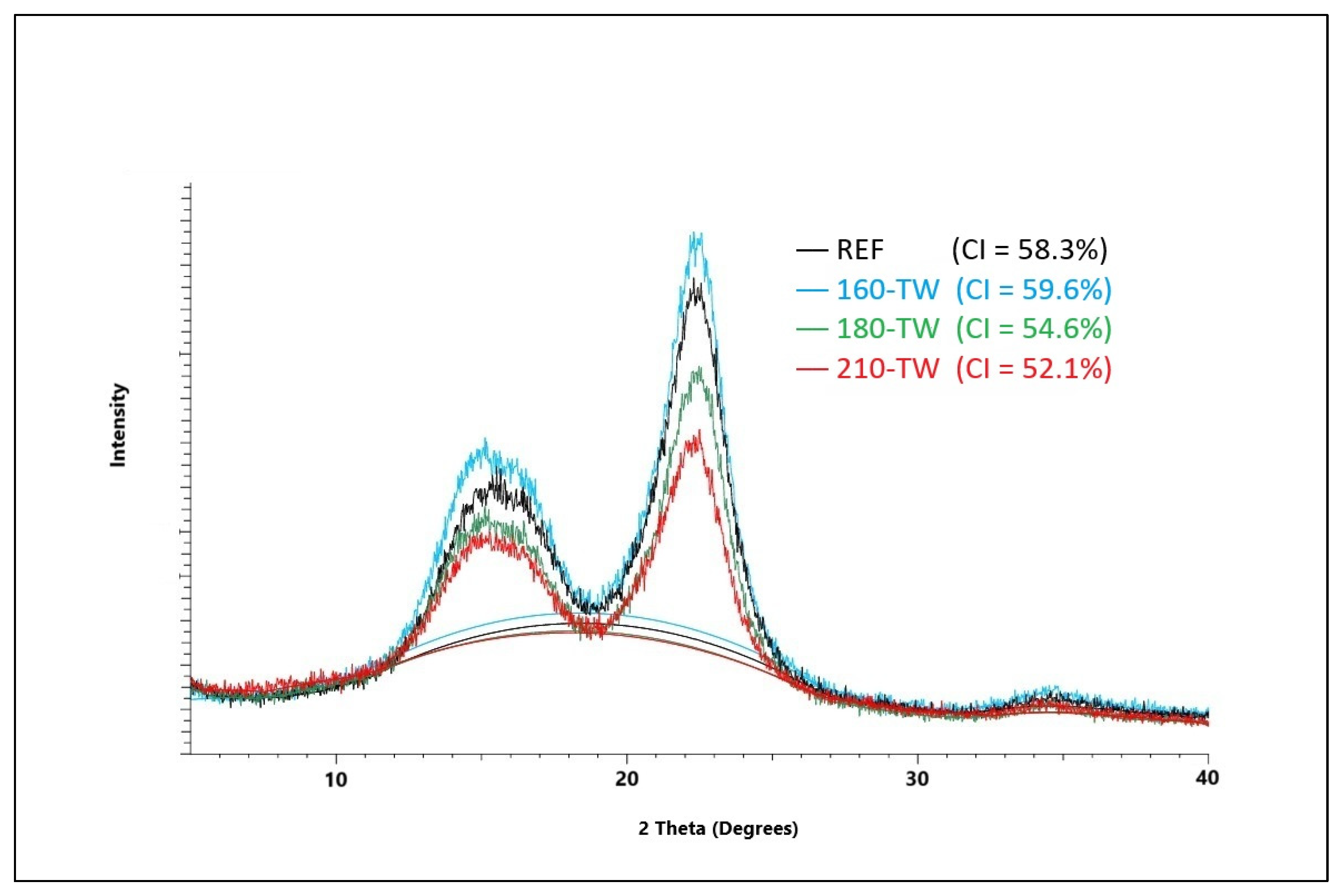
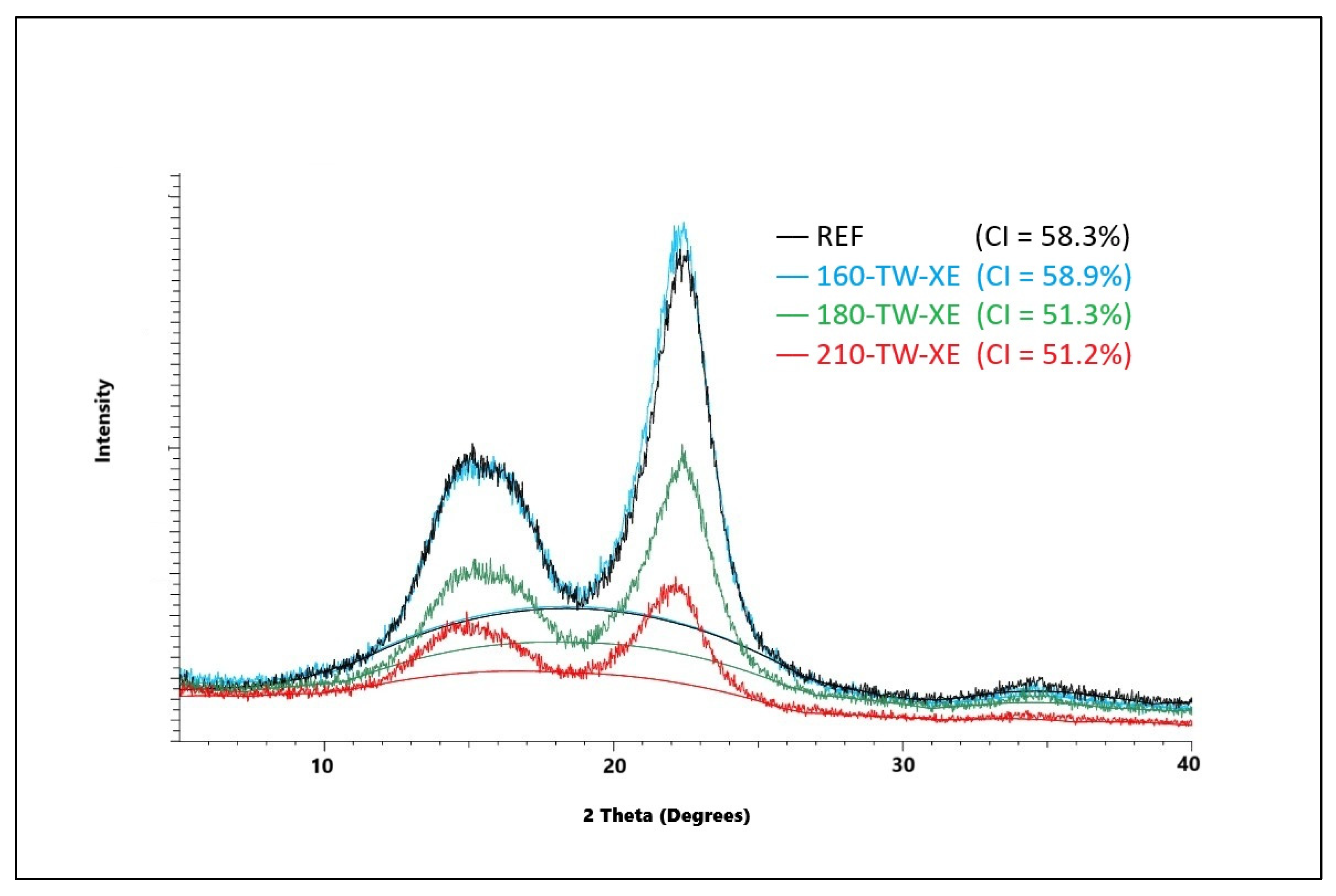

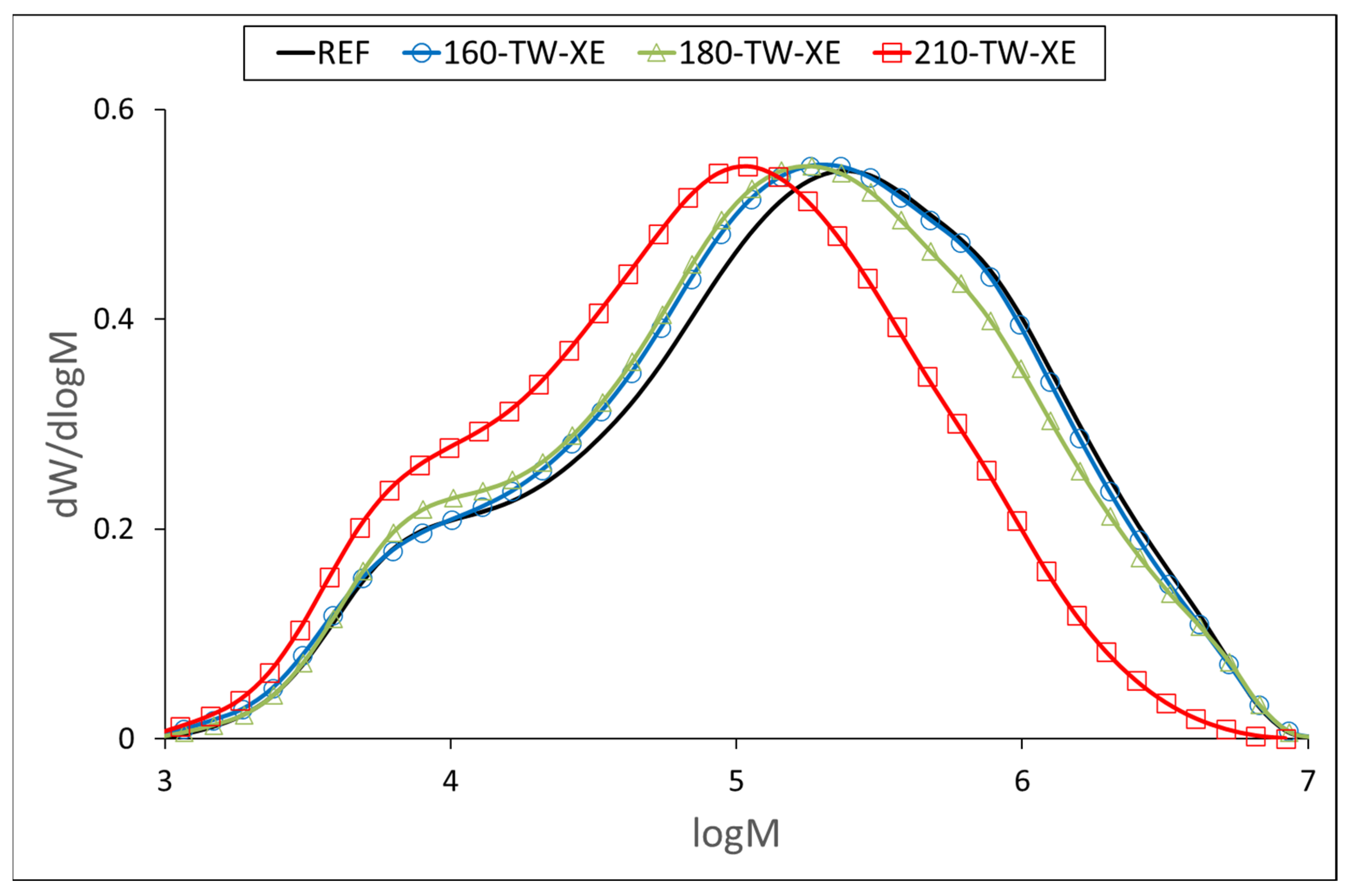
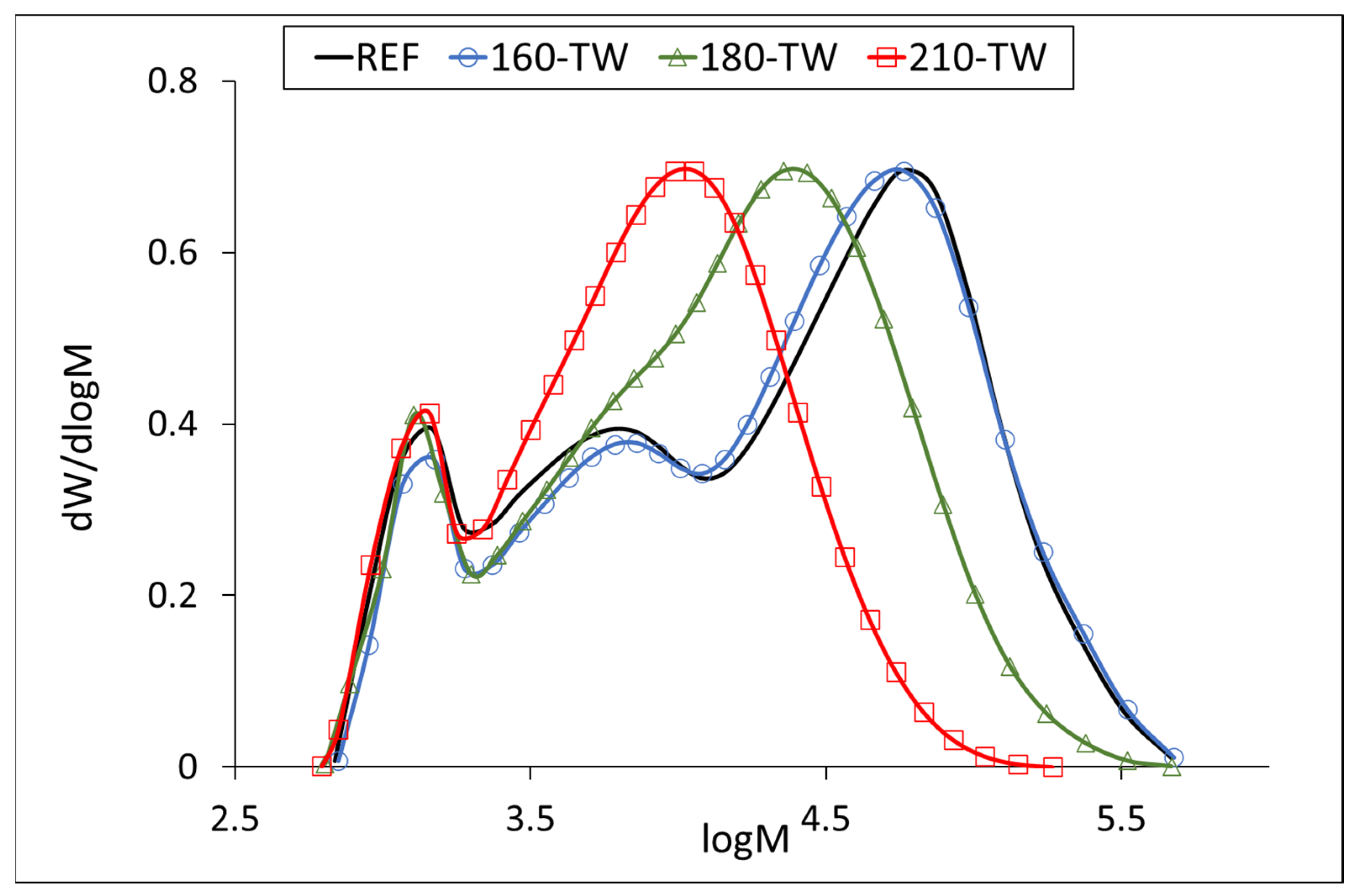

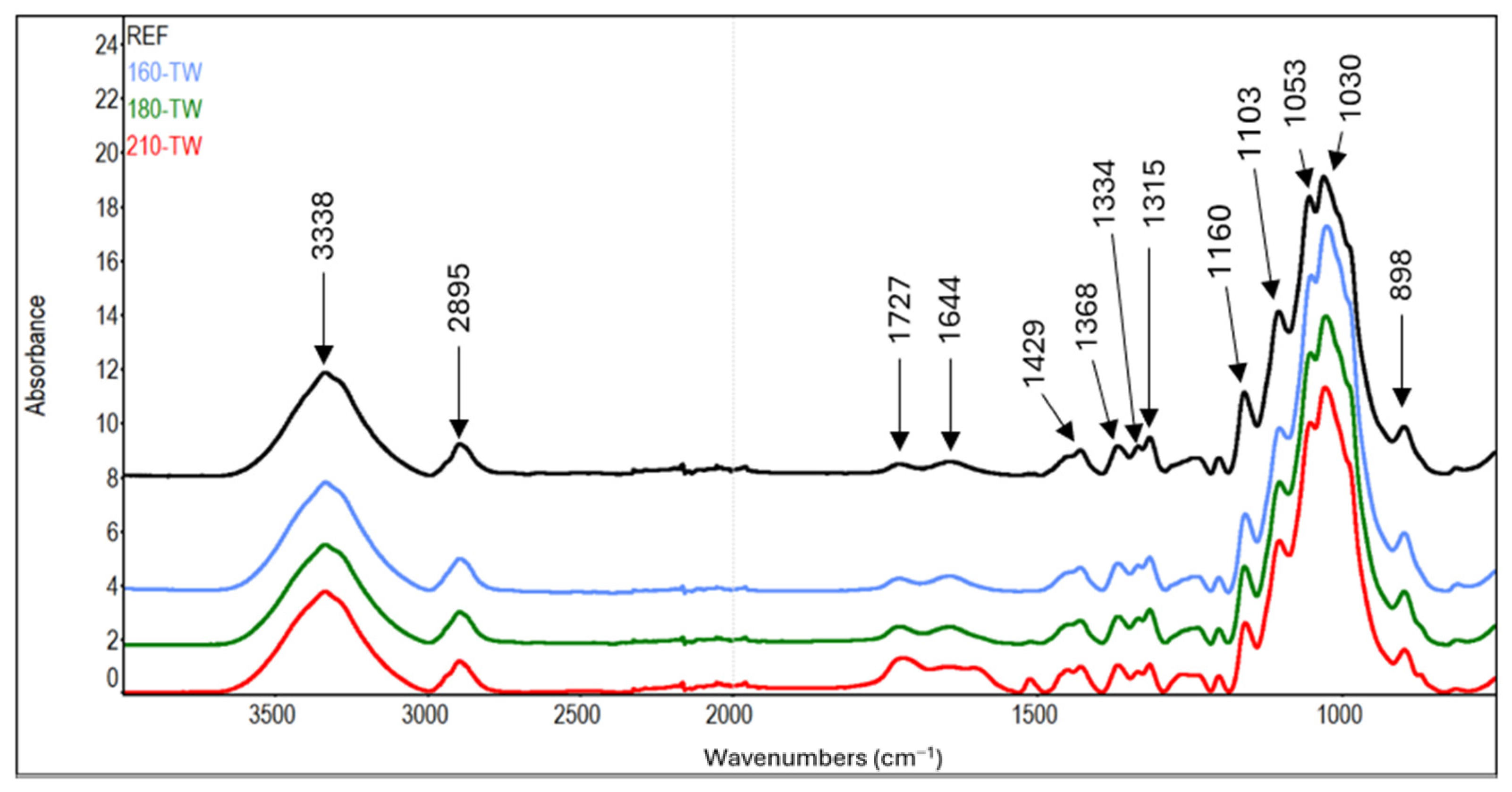
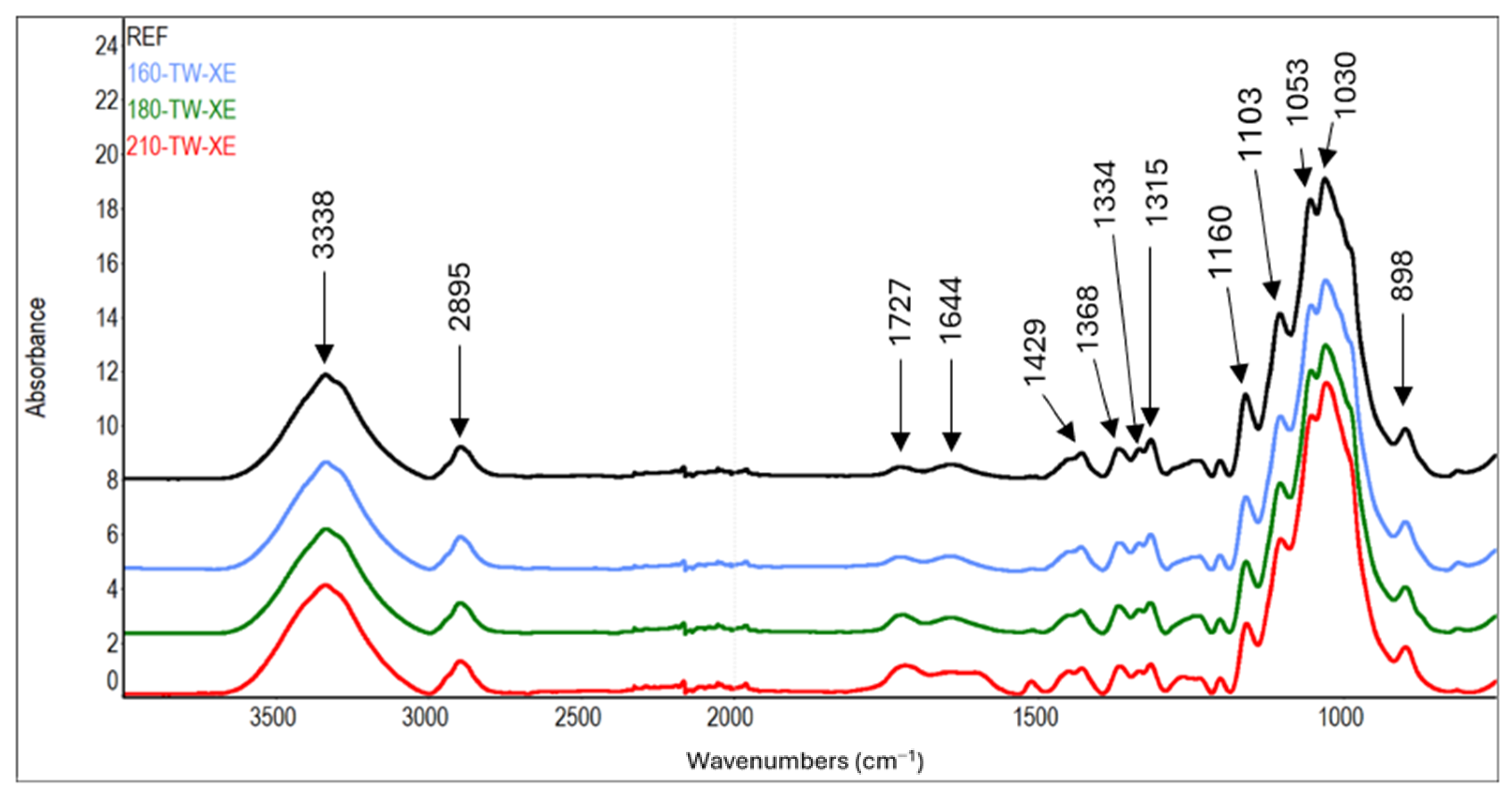
| Step | Mode | Radiation Intensity (W·m−2) | Black Panel Temperature (°C) | Air Temperature (°C) | Relative Air Humidity (%) | Time (min) |
|---|---|---|---|---|---|---|
| 1 | Radiation | 0.35 | 63 | 48 | 30 | 102 |
| 2 | Radiation + water spraying | 0.35 | 63 | 48 | 90 | 18 |
| T (°) | TW | TW-XE | ||||
|---|---|---|---|---|---|---|
| Holo- Cellulose | Cellulose | Hemi- Celluloses | Holo- Cellulose | Cellulose | Hemi- Celluloses | |
| REF | 77.43 (0.61) | 45.35 (0.26) | 32.07 (0.68) | 77.43 (0.61) | 45.35 (0.26) | 32.07 (0.68) |
| 160 | 76.29 (0.78) | 45.48 (0.14) | 30.81 (0.81) | 76.38 (0.36) | 45.38 (0.12) | 31.00 (0.40) |
| 180 | 66.93 (0.61) | 46.33 (0.21) | 20.59 (0.81) | 62.72 (0.36) | 45.23 (0.37) | 17.49 (0.54) |
| 210 | 58.39 (0.12) | 58.39 (0.17) | 7.83 (0.16) | 58.82 (0.22) | 52.56 (0.11) | 6.26 (0.12) |
| Sample | Glucose (GLC) | Xylose (XYL) | Galactose (GAL) | Arabinose (ARA) | Mannose (MAN) | Total |
|---|---|---|---|---|---|---|
| REF | 48.24 (0.83) | 6.52 (0.10) | 3.47 (0.03) | 3.32 (0.31) | 11.32 (0.16) | 72.87 (0.99) |
| 160-TW | 44.31 (0.53) | 4.98 (0.11) | 3.09 (0.09) | 1.61 (0.08) | 10.48 (0.16) | 64.47 (0.89) |
| 180-TW | 41.46 (0.06) | 4.94 (0.06) | 1.84 (0.08) | 1.71 (0.06) | 9.00 (0.13) | 58.95 (0.17) |
| 210-TW | 40.38 (0.22) | 3.57 (0.05) | 1.00 (0.07) | 1.11 (0.09) | 7.82 (0.16) | 53.87 (0.38) |
| 160-TW-XE | 43.07 (0.32) | 4.92 (0.21) | 2.91 (0.04) | 1.64 (0.33) | 10.40 (0.41) | 62.94 (1.14) |
| 180-TW-XE | 38.18 (0.57) | 5.18 (0.10) | 2.63 (0.03) | 1.55 (0.05) | 7.81 (0.21) | 55.35 (0.88) |
| 210-TW-XE | 37.44 (0.34) | 3.78 (0.12) | 1.42 (0.05) | 0.88 (0.03) | 7.12 (0.09) | 50.64 (0.56) |
| Sample | Glucose (GLC) | Xylose (XYL) | Galactose (GAL) | Arabinose (ARA) | Mannose (MAN) |
|---|---|---|---|---|---|
| REF | 64.75 (0.36) | 9.33 (0.13) | 4.96 (0.05) | 4.76 (0.42) | 16.21 (0.16) |
| 160-TW | 68.73 (0.16) | 7.73 (0.06) | 4.79 (0.14) | 2.50 (0.09) | 16.25 (0.04) |
| 180-TW | 70.33 (0.11) | 8.39 (0.09) | 3.12 (0.13) | 2.89 (0.10) | 15.27 (0.21) |
| 210-TW | 74.96 (0.45) | 6.63 (0.07) | 1.85 (0.12) | 2.06 (0.16) | 14.51 (0.24) |
| 160-TW-XE | 68.44 (0.99) | 7.82 (0.23) | 4.62 (0.03) | 2.60 (0.47) | 16.52 (0.35) |
| 180-TW-XE | 68.98 (0.18) | 9.35 (0.05) | 4.76 (0.13) | 2.80 (0.05) | 14.11 (0.19) |
| 210-TW-XE | 73.94 (0.24) | 7.46 (0.16) | 2.80 (0.08) | 1.73 (0.07) | 14.07 (0.03) |
| Sample | Mn | Mw | Mz | PDI | DP |
|---|---|---|---|---|---|
| REF | 13,590 (252) | 196,859 (9276) | 703,596 (12,596) | 14.48 (0.42) | 1215 (57) |
| 160-TW | 13,531 (138) | 215,639 (3374) | 750,340 (8230) | 15.94 (0.39) | 1338 (20) |
| 180-TW | 12,061 (286) | 164,887 (5165) | 629,976 (19,977) | 13.67 (0.11) | 1027 (32) |
| 210-TW | 8720 (109) | 99,330 (2559) | 431,606 (9563) | 11.39 (0.15) | 610 (18) |
| 160-TW-XE | 13,532 (607) | 214,154 (20,431) | 754,195 (42,805) | 15.83 (0.80) | 1322 (126) |
| 180-TW-XE | 13,072 (316) | 191,052 (2551) | 734,342 (4990) | 14.62 (0.16) | 1179 (16) |
| 210-TW-XE | 8769 (85) | 96,640 (2400) | 413,036 (15,473) | 11.02 (0.17) | 597 (15) |
| Sample | Mn | Mw | Mz | PDI |
|---|---|---|---|---|
| REF | 6941 (115) | 45,278 (210) | 143,947 (5873) | 6.52 (0.14) |
| 160-TW | 6256 (721) | 44,305 (3052) | 141,816 (1549) | 7.10 (0.33) |
| 180-TW | 6869 (32) | 27,205 (176) | 85,926 (2590) | 3.96 (0.01) |
| 210-TW | 5300 (371) | 13,597 (21) | 27,680 (1906) | 2.57 (0.18) |
| 160-TW-XE | 7066 (213) | 42,191 (207) | 122,628 (9765) | 5.97 (0.15) |
| 180-TW-XE | 7186 (88) | 24,929 (2) | 60,378 (752) | 3.47 (0.04) |
| 210-TW-XE | 4930 (30) | 13,274 (347) | 35,063 (3818) | 2.69 (0.09) |
| Wavenumber (cm−1) | ΔTW (%) | ΔTW-XE (%) | ||||
|---|---|---|---|---|---|---|
| 160 °C | 180 °C | 210 °C | 160 °C | 180 °C | 210 °C | |
| 898 | 17.49 | 10.06 | −11.39 | 4.46 | −9.85 | −1.60 |
| 1030 | 19.20 | 9.37 | 3.22 | −3.90 | −4.35 | 6.67 |
| 1053 | 10.33 | 3.96 | −2.35 | −5.58 | −6.43 | 2.28 |
| 1103 | −3.03 | −1.66 | −6.02 | −6.31 | −8.83 | −3.39 |
| 1160 | −7.09 | −6.08 | −14.63 | −11.82 | −13.91 | −13.57 |
| 1202 | −12.91 | −10.24 | −7.75 | −10.80 | −18.16 | −12.38 |
| 1261 | 2.36 | 24.42 | 68.46 | −1.36 | 25.89 | 50.82 |
| 1315 | −2.24 | −0.09 | −19.33 | 1.88 | −9.09 | −18.81 |
| 1334 | −2.87 | −2.80 | −20.37 | 1.82 | −8.60 | −16.86 |
| 1429 | −8.40 | −6.49 | 6.10 | −6.15 | −10.17 | 3.15 |
| 1450 | −0.54 | 6.64 | 27.21 | 3.34 | 1.08 | 25.32 |
| 1512 | −42.82 | 74.72 | 1107.14 | 40.74 | 122.37 | 923.57 |
| 1644 | 11.18 | 21.35 | 78.89 | −4.81 | 12.99 | 67.16 |
| 1727 | 26.01 | 58.44 | 221.10 | 14.94 | 85.31 | 193.35 |
| 2895 | 1.62 | −0.05 | −2.28 | 3.66 | −2.83 | 6.53 |
| 3338 | 1.18 | −4.80 | −3.67 | 2.73 | 0.13 | 7.01 |
Disclaimer/Publisher’s Note: The statements, opinions and data contained in all publications are solely those of the individual author(s) and contributor(s) and not of MDPI and/or the editor(s). MDPI and/or the editor(s) disclaim responsibility for any injury to people or property resulting from any ideas, methods, instructions or products referred to in the content. |
© 2025 by the authors. Licensee MDPI, Basel, Switzerland. This article is an open access article distributed under the terms and conditions of the Creative Commons Attribution (CC BY) license (https://creativecommons.org/licenses/by/4.0/).
Share and Cite
Kačík, F.; Jurczyková, T.; Bálintová, M.; Kmeťová, E.; Výbohová, E.; Kačíková, D. Saccharide Alterations in Spruce Wood Due to Thermal and Accelerated Aging Processes. Polymers 2025, 17, 1265. https://doi.org/10.3390/polym17091265
Kačík F, Jurczyková T, Bálintová M, Kmeťová E, Výbohová E, Kačíková D. Saccharide Alterations in Spruce Wood Due to Thermal and Accelerated Aging Processes. Polymers. 2025; 17(9):1265. https://doi.org/10.3390/polym17091265
Chicago/Turabian StyleKačík, František, Tereza Jurczyková, Magdaléna Bálintová, Elena Kmeťová, Eva Výbohová, and Danica Kačíková. 2025. "Saccharide Alterations in Spruce Wood Due to Thermal and Accelerated Aging Processes" Polymers 17, no. 9: 1265. https://doi.org/10.3390/polym17091265
APA StyleKačík, F., Jurczyková, T., Bálintová, M., Kmeťová, E., Výbohová, E., & Kačíková, D. (2025). Saccharide Alterations in Spruce Wood Due to Thermal and Accelerated Aging Processes. Polymers, 17(9), 1265. https://doi.org/10.3390/polym17091265








